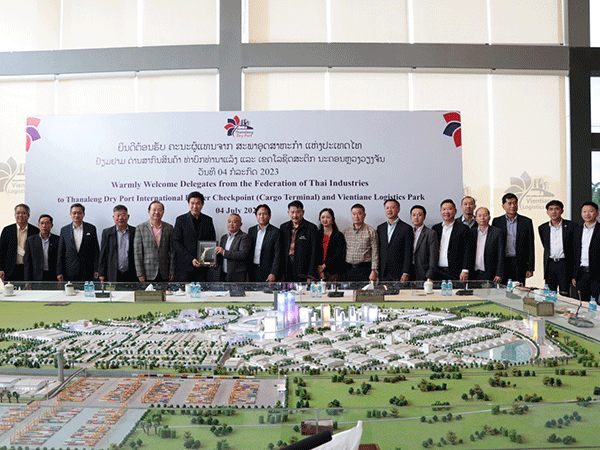A delegation from the Federation of Thai Industries is surveying a rail trade route connecting Thailand to Laos and China, which can also reach the European market.

Led by the federation’s Chairman of the Asean and Logistics Committee, Vathit Chokwatana, the business group surveyed the Bangkok-Vientiane-Mohan-Kunming rail route, visiting various sites from July 4-7.
On their first day, the group toured the Thanaleng Dry Port in Vientiane to learn about the opportunities offered through the landmark project and railways.
As a converging point between the Laos-Thailand and Laos-China railways, the dry port is an important trade hub between Southeast Asian countries and China, the facility’s Managing Director Sakhone Philangam told the guests.
Connecting to the China-Europe rail network, cargo can continue onward through Kazakhstan, Russia, Belarus and Poland and even reach Duisburg in Germany. By rail, it takes about two weeks to move goods from Southeast Asia to Europe as opposed to 45 days by sea.
Thanks to the cost-effective services offered, many foreign logistics and transport service providers, notably from Thailand, have exported goods to China through the dry port and railways.
President of Thailand’s Kaocharoen Train Transport Co., Ltd., Panya Paputsaro, told the Vientiane Times previously that shipment of cargo from Thailand to China through Laos by rail cuts transport costs by 30 percent compared to road transport, which also takes longer.
In light of the lucrative opportunities, Mr Panya’s company and other partners joined the Pan Asia Silk Road Co., Ltd. (PAS) launched in April, with the first Thailand-Laos-China freight train travelling from Thailand’s Map Ta Phut station in Rayong to Guangzhou in China through Laos.
Since opening for service in December 2021, the integrated dry port has processed numerous direct shipments by rail between Thailand and China, according to the operator.
Fast rail transport is especially beneficial for the shipment of fresh fruit from Thailand – a major grower of farm produce – to Chinese buyers, particularly durian, which are very popular in China.
The multimodal transport node dry port network connects to Laem Chabang, Thailand’s main deep seaport, about 150km south of Bangkok. From Bangkok, the trade route connects to the Malaysian capital Kuala Lumpur and onwards to Singapore.
To improve services and speed up the shipment of freight between Southeast Asian countries and China, which are key trading partners, the dry port’s developer is working with China to build an SPS (sanitary and phytosanitary measures) inspection centre at the port. Once the SPS centre becomes operational, it will speed up the certification and cross-border shipment of farm produce.
To tap the trade and investment potential brought about by improved transport and logistics connectivity, Vientiane Logistics Park Co., Ltd. - the developer of the dry port - is also building a logistics complex where companies can set up operations and benefit from a number of financial incentives.
The complex comprises seven zones, including a tank farm, export processing centre, logistics park, free trade zone, technology and halal hub, and administrative and office zone.
Investors can benefit from incentives such as a corporate tax holiday of 8-16 years and lower Value-Added Tax, with cheap electricity being an added bonus.
Companies that manufacture or assemble goods in Laos enjoy privileged access to major markets in countries whose governments have waived or reduced import tariffs on made-in-Laos products.
More than 30 countries including Australia, Canada, members of the European Union (EU 28), Japan, New Zealand, Norway, Russia, Switzerland and Turkiye have extended such privileges to Laos.
The Thai business group visiting the dry port included executives from Saha Pathanapibul PLC, P.F.P. Trading Co., Ltd., Charoen Pokphand Group, T.K. Garment Co., Ltd., Building Materials Co., Ltd., SCGJWD Logistics Public Company Limited, TS Inter Supply and Service Co., Ltd., and True Corporation Public Company Limited.
Source: Vientiane Times